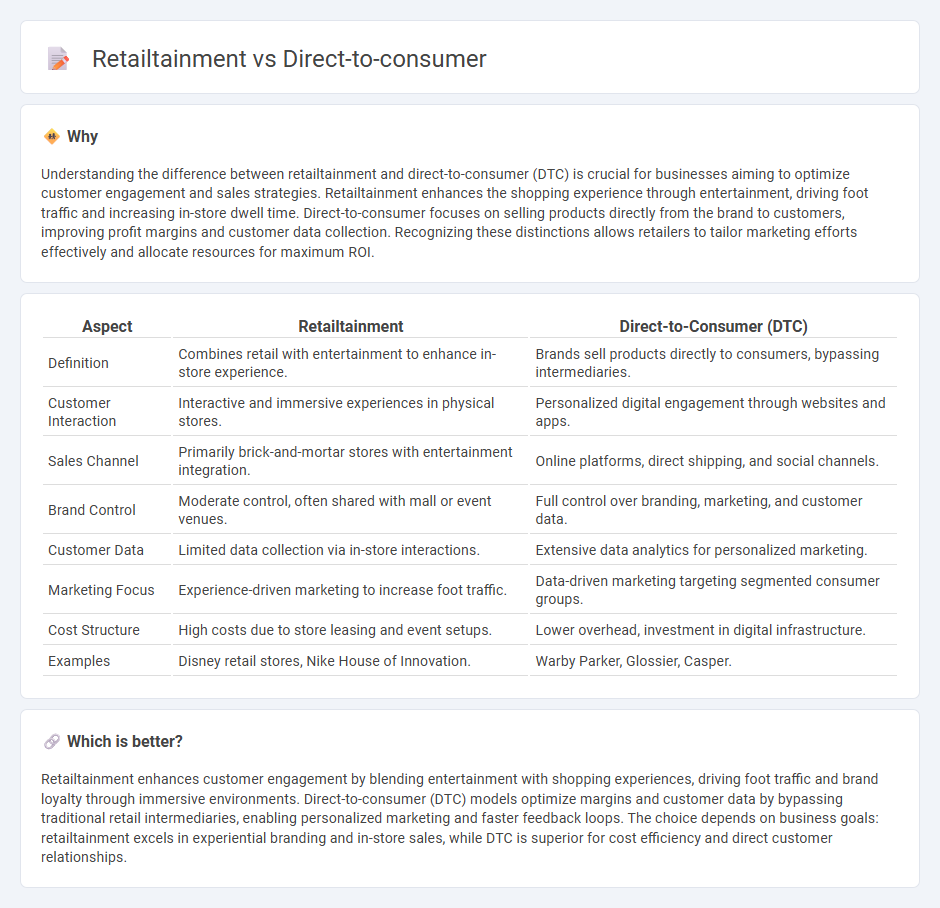
Retailtainment blends entertainment and shopping to enhance customer engagement and increase in-store foot traffic, leveraging immersive experiences such as interactive displays and live events. Direct-to-consumer (DTC) models bypass traditional retail intermediaries, enabling brands to build stronger relationships with customers through personalized marketing, data-driven insights, and improved profit margins. Explore how these innovative strategies are reshaping the retail landscape and driving consumer loyalty.
Why it is important
Understanding the difference between retailtainment and direct-to-consumer (DTC) is crucial for businesses aiming to optimize customer engagement and sales strategies. Retailtainment enhances the shopping experience through entertainment, driving foot traffic and increasing in-store dwell time. Direct-to-consumer focuses on selling products directly from the brand to customers, improving profit margins and customer data collection. Recognizing these distinctions allows retailers to tailor marketing efforts effectively and allocate resources for maximum ROI.
Comparison Table
| Aspect | Retailtainment | Direct-to-Consumer (DTC) |
|---|---|---|
| Definition | Combines retail with entertainment to enhance in-store experience. | Brands sell products directly to consumers, bypassing intermediaries. |
| Customer Interaction | Interactive and immersive experiences in physical stores. | Personalized digital engagement through websites and apps. |
| Sales Channel | Primarily brick-and-mortar stores with entertainment integration. | Online platforms, direct shipping, and social channels. |
| Brand Control | Moderate control, often shared with mall or event venues. | Full control over branding, marketing, and customer data. |
| Customer Data | Limited data collection via in-store interactions. | Extensive data analytics for personalized marketing. |
| Marketing Focus | Experience-driven marketing to increase foot traffic. | Data-driven marketing targeting segmented consumer groups. |
| Cost Structure | High costs due to store leasing and event setups. | Lower overhead, investment in digital infrastructure. |
| Examples | Disney retail stores, Nike House of Innovation. | Warby Parker, Glossier, Casper. |
Which is better?
Retailtainment enhances customer engagement by blending entertainment with shopping experiences, driving foot traffic and brand loyalty through immersive environments. Direct-to-consumer (DTC) models optimize margins and customer data by bypassing traditional retail intermediaries, enabling personalized marketing and faster feedback loops. The choice depends on business goals: retailtainment excels in experiential branding and in-store sales, while DTC is superior for cost efficiency and direct customer relationships.
Connection
Retailtainment enhances the direct-to-consumer (DTC) model by creating engaging, experience-driven shopping environments that foster stronger emotional connections between brands and consumers. This approach leverages immersive events, interactive displays, and personalized services, driving customer retention and boosting online and offline sales channels. The fusion of retailtainment with DTC strategies allows brands to differentiate themselves in competitive markets by merging entertainment with streamlined, direct purchasing options.
Key Terms
Distribution Channel
Direct-to-consumer (DTC) channels enable brands to sell products directly to customers through online platforms, reducing reliance on intermediaries and increasing control over customer data and brand experience. Retailtainment integrates entertainment elements into physical retail spaces to enhance customer engagement and drive foot traffic, blending shopping with leisure activities. Explore how these distinct distribution strategies reshape customer interaction and sales dynamics.
Customer Experience
Direct-to-consumer (DTC) brands prioritize personalized experiences by leveraging data analytics and seamless online interfaces, enhancing customer engagement and satisfaction. Retailtainment blends entertainment with shopping, creating interactive environments that boost in-store dwell time and emotional connection with the brand. Explore how these approaches redefine customer experience to elevate brand loyalty and sales.
Brand Engagement
Direct-to-consumer (DTC) strategies enhance brand engagement by offering personalized shopping experiences and direct communication, fostering stronger customer loyalty and data-driven marketing. Retailtainment integrates interactive entertainment within physical retail spaces, creating memorable experiences that increase foot traffic and emotional connection to the brand. Explore how combining DTC and retailtainment can revolutionize brand engagement strategies.
Source and External Links
Direct-to-consumer - Direct-to-consumer (DTC) is a business model where brands sell products directly to customers, bypassing third-party retailers or wholesalers, often through online platforms, allowing for more direct engagement with buyers and control over sales.
Direct to Consumer (D2C) Guide - D2C means brands sell straight to end users without retail partners, commonly via ecommerce sites and apps, enabling manufacturers to build direct relationships and control digital commerce channels.
What Is Direct-to-Consumer? Everything You Need To Know - The DTC model provides brands total control over marketing, fulfillment, and customer data by selling directly to consumers online, often complemented by physical stores focused on experience rather than sales.
 dowidth.com
dowidth.com